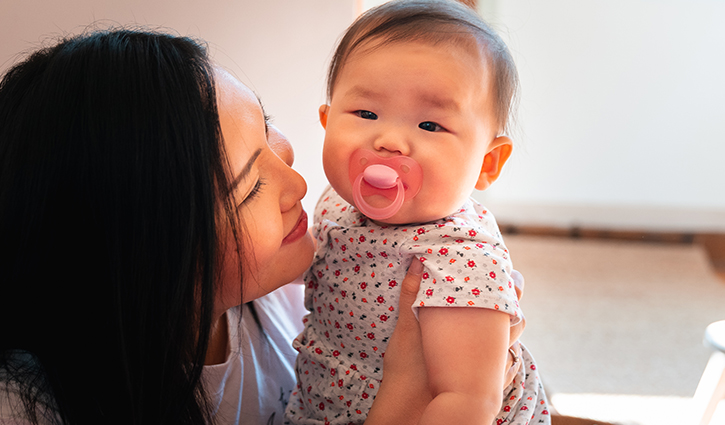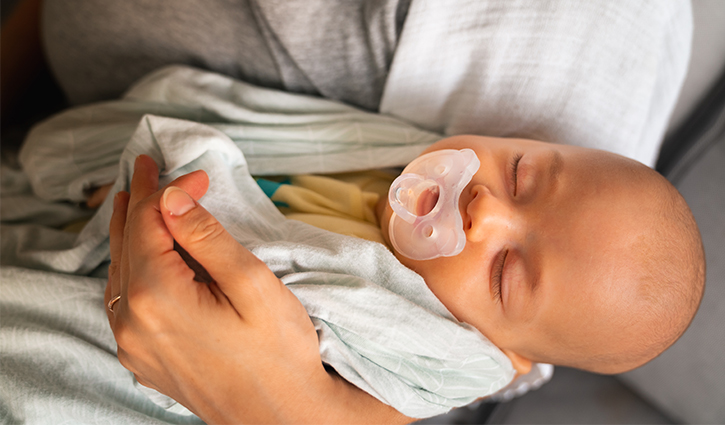

Sucking is a natural, comforting reflex for newborns, so it’s no wonder that many of them (and their parents) love a soother, dummy, pacifier, or whatever you like to call it. If you’re thinking that introducing a soother will help to calm your baby during unsettled periods or even assist them to sleep slightly longer stretches at night (who wouldn’t want that!), then you’ll need to choose the right one for your bub.
You wouldn’t be alone in assuming that all soothers are basically made the same, but look a little closer at their designs and features, and there are definitely better suited ones that are uniquely created with newborns in mind.

Here you’ll find everything you need to look for in choosing the right newborn soother for your special little one. Then, continue reading for some simple tips to take good care of them to ensure they’re kept safe and hygienic.
How to choose the right newborn soother
When looking at a soother for your newborn, ensure that it ticks all of these boxes:
- Developmental stage: If you would like to offer your bub a soother early on, you’ll want one that’s designed for babies under 2 months (and can be used from birth). Many on the market are designed for babies aged 0-3 months, and as you’d imagine a 3 week-old’s mouth is very different to a 3 month-old’s.
- Teat: Look for an extra small teat to fit a smaller baby’s oral cavity, and one that is made from soft and flexible silicone to enable your baby to squeeze it easily as their tongue muscle is in its early stage of development. The right sized teat provides better support to the natural suckling movements that ultimately calm your baby.
- Weight: The soother should be extra lightweight, as a heavy one could put stress on your baby’s developing orofacial muscles. These muscles are used in chewing, swallowing, and speech.
- Airflow: Ensure it features small holes for airflow between your baby’s skin and the shield of the soother. These air holes also minimise the unlikely event of choking if the baby manages to get the entire soother in their mouth (it does happen occasionally).
- Ergonomic: The entire design should be extra small, so as not to block any part of your baby’s nose – you want your baby to be able to still smell your comforting scent. Look for an angel-wing shape rather than a round-shaped shield, so that it fits the contours of your baby’s face to prevent any pressure points. This will minimise the risk of redness and irritation in your baby’s delicate skin.
- Materials: If you’re looking at plastic soothers, it’s essential that it is made without BPA and BPS, to minimise any associated health risks (there are concerns that these chemicals can leach out of products and disrupt hormones in infants).
- Safety: The soother should be designed to meet the safety regulation EN 1400, which states how large the shield must be to prevent babies from swallowing their soother.
- Orthodontic: The symmetrical teat (meaning it has the same shape on the upper and lower parts) ideally should have a thin neck to minimise the space between the upper and lower jaw. The teat also needs to be flat so that it takes up less space in the mouth, allowing for better natural tongue movement.
How to care for your newborn’s soother
As you can see, it’s not just a matter of grabbing any soother off the supermarket shelves. Since your baby is tiny, their mouth is small, and they’re developing important muscles that they’ll need for eating solids and speaking, it’s a purchase that requires careful selection.
So, now that you know what to look for in a soother, what’s the best way to care for it? They will come with manufacturer’s instructions, but generally, the steps are as follows:
- Before the first time you use it, boil the soother for 5 minutes. Allow it to cool thoroughly before giving it to your baby, and also ensure that any residual water in the teat is squeezed out first.
- Before giving it to your baby each time, it’s a good idea to wash it with warm water.
- You might choose to sterilise the soother regularly in the early months since your baby’s immune system is immature. Some soothers even come with their own sterilisation box that allows you to sterilise them in the microwave in just a few minutes.
- If your baby uses a soother every day, it’s recommended that they’re replaced every 1-2 months to maintain their safe and hygienic condition.
- Before each use, pull firmly on the teat and inspect it for tears and holes. Always replace immediately if you notice any signs of damage or wear.
- Replace soothers also after your baby has had an infection, such as a cold or stomach bug.























